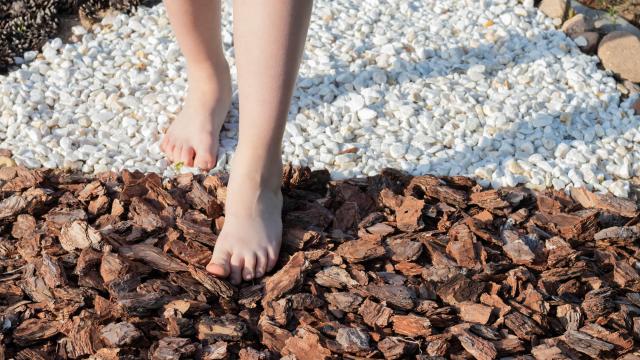Sensory paths are a popular feature in schools, as they can engage kids in ways that promote focus and calm. These are all things that many adults could stand to be reminded of, so a garden sensory path doesn’t have to be just for kids.
A sensory garden path can be a great feature for anyone looking to up their mindfulness game, or who needs a place to retreat when they need help centering themselves and restoring their emotional equilibrium, and you can create one in your yard. Here are some tips to get you started on designing and installing your own sensory path.
What is a sensory path?
Sensory paths, as their name implies, should be designed to engage one or more specific senses and exercise skills or experience with these senses. Gardens naturally stimulate your visual sense, but a sensory path should also aim to include touch, sound, and scent. Incorporating different textures or types of terrain, using plants that have different scents, and choosing materials that produce varied sounds when they are tread on are all good ideas for a sensory garden path.
First, lay out your path
To plan your path, mark out the area you want the path to travel with Bamboo stakes or string. Once you have the shape planned, remove any vegetation from the area and smooth out the soil. Cover your smoothed area with landscaping fabric and tie the fabric down with landscaping pegs or landscaping staples to hold it in place.
Pick your pavers
Now, the fun part: You can choose from lots of different materials to create your pathway and border. A good mix of materials would include gravel, some stepping stones, larger stone or pavers, and tree rounds or wooden planks — plus soil or sand to go between them.
Whatever you choose for your pavers, make sure they offer a few different textures and will produce varied sounds when walked on. You can incorporate brick or concrete pavers as well as natural textures — just make sure to mix it up.
Plan your progression
Divide your pathway into sections — think of drawing a hopscotch course — and arrange your pavers in each section. You can create stark contrasts (going grom gravel to smooth paver stones) or you could choose a more gradual progression (from small gravel to large gravel and then finally to pavers or brick). Whatever arrangement you find inspiring to your senses will work.
Backfill crevices with sand, gravel, moss or creeping thyme to add more unusual textures while eliminating tripping hazards, and your path layout will be complete.
Add a border
Along the edges of the path, add some plants that might brush against your ankles, sway in the breeze, or add some colour. It’s a good idea to choose species that will stay where you put them so you’re not constantly weeding them out of the pathway. Rush grass that grows in clumps is a good option for texture, as are flowers like acanthus and astilbe for their feathery qualities.
For scent, plants like creeping thyme, lavender, and jasmine are good choices. Add colour by lining your path with bulb flowers, or really, any flowers you like and that grow well in your area. As when you were designing your main path, keep diversity in mind when choosing your edge plantings — for a satisfying sensory experience, variety is key.

Leave a Reply
You must be logged in to post a comment.